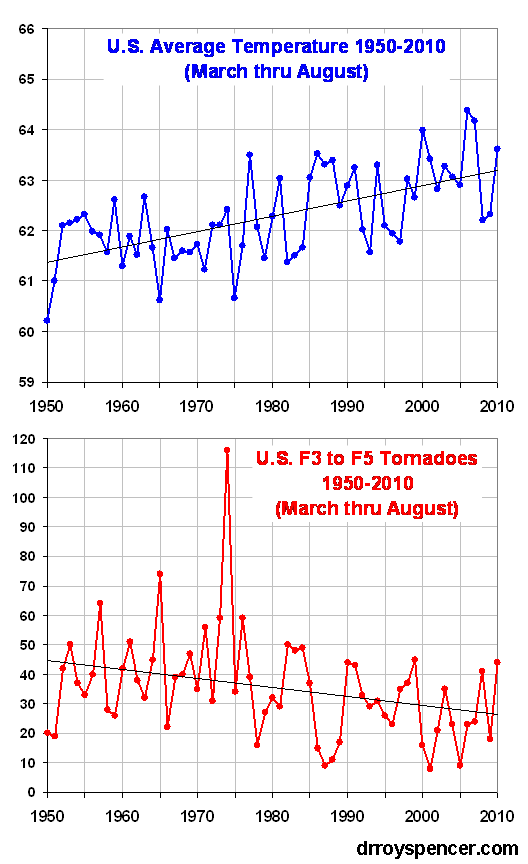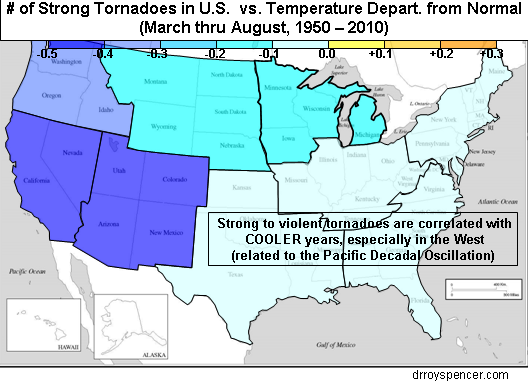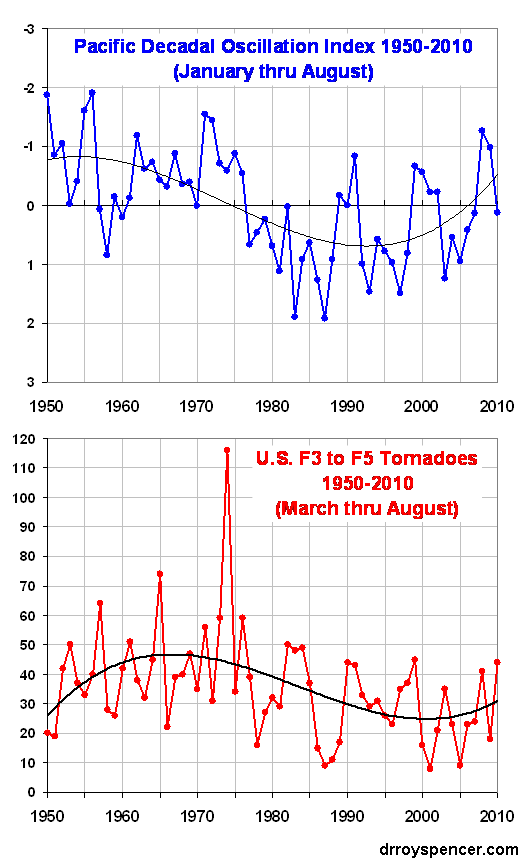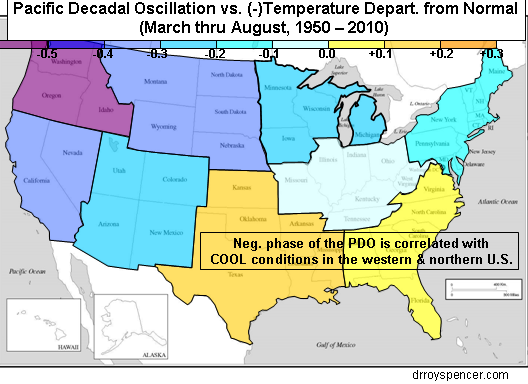|
|
Post by marchesarosa on May 19, 2011 9:54:24 GMT 1
Wow! Michael Mann has predicted 16 plus or minus 4 hurricanes for the upcoming season! A range of 8 for a total of 16, that's some leeway! Are these error bars big enough to satisfy STA? Joe Bastardi says 14 plus or minus 1. But then he's an experienced meteorologist whereas Mann just cannot afford to be wrong (again). Article here by Joe Bastardi of Weatherbell wattsupwiththat.com/2011/05/18/joe-bastardis-hurricane-season/#more-40220 |
|
|
|
Post by marchesarosa on May 25, 2011 3:38:24 GMT 1
|
|
|
|
Post by marchesarosa on May 25, 2011 14:56:45 GMT 1
Today’s Tornado Outlook: High Risk of Global Warming Hypeby Dr Roy spencer May 24th, 2011 After the catastrophic death toll from the Joplin, MO tornado, which now stands at 117, we are no doubt in for more claims — dutifully amplified by the news media — that ‘climate change’ must somehow be at least partly responsible for this Spring’s wild weather. And, to some extent, I’m inclined to agree. That is, if they are talking about the natural cooling effects of La Nina and the tendency for tornado outbreaks to be associated with cooler (not warmer) climate conditions. But I suspect that’s just the opposite of the message they will be preaching. So, let’s look at 2 statistics: 1) the number of strong to violent tornadoes, and 2) the deadliest tornadoes in U.S. history THE DOWNTURN IN STRONG TORNADOES WITH WARMING The bottom panel of following graphic shows what most meteorologists already know: there has been a downward trend in strong (F3) to violent (F5) tornadoes in the U.S. since statistics began in the 1950s. As seen in the top panel, this has also been a period of general warming. For those statistics buffs, the correlation coefficient is -0.31. Obviously, the conclusion should be that warming causes fewer strong tornadoes, not more. (Or, maybe a lack of tornadoes causes global warming!)  Even when I de-trend the data, the remaining year-to-year variability still has a negative correlation: -0.17, so the conclusion is the same for the long-term trend AND the year-to-year variations in strong tornado activity. So how does anyone get away with claiming that global warming is contributing to more tornadoes? Well, maybe because there has indeed been an UPward trend in total reported tornado sightings in the U.S. during the same period of time. But this is only because (as I mention in my first book, Climate Confusion) there are so many more people now spread across the fruited plain, with so many video cameras, and now so many Doppler radars are measuring the wind rotation associated with tornadoes, that it is difficult for any to go unnoticed by at least someone. THE DOWNTURN IN TORNADO DEATHS Also, if you hear any news reports that more deaths due to tornadoes are due to global warming, this is also a bogus claim. Here’s a little quiz for you: QUESTION: Out of the 25 deadliest tornadoes in U.S history, how many would you guess have occurred in the last 50 years (since 1960)? …wait for it…. ANSWER: Up until a month ago, NONE of them. On April 27, one of the Alabama tornadoes made the bottom of the list at #25, but now has been knocked back off the list because Sunday’s tornado in Joplin will be ranked #8. So, to the extent that you hear reports of ANYONE connecting tornadoes to global warming, I think it proves only one thing: The belief that global warming is causing most of the world’s ills is so pervasive that the facts simply do not matter anymore. www.drroyspencer.com/2011/05/todays-tornado-outlook-high-risk-of-global-warming-hype/
|
|
|
|
Post by marchesarosa on May 25, 2011 15:46:06 GMT 1
Be glad we don't get bombarded with these in the UK - 5.25 " diameter  |
|
|
|
Post by marchesarosa on May 25, 2011 18:13:49 GMT 1
The Tornado – Pacific Decadal Oscillation ConnectionSpencer cont'd.... There are 2 main reasons why stronger tornadoes are usually associated with unseasonably cool conditions, and why there has been a decrease in strong tornadoes during a period of average warming: 1) The missing ingredient for tornado formation is not a lack of warm moist air, but a lack of synoptic (large) scale wind shear www.weatherquestions.com/What_is_wind_shear.htm. 2) At least until recently, the positive phase of the Pacific Decadal Oscillation (PDO) which has predominated since the late 1970’s has suppressed strong tornado activity. Let’s look at these two issues. THE MISSING INGREDIENT: WHY 99% OF THUNDERSTORMS DO NOT PRODUCE TORNADOES I’ve been trying to think of why some might assume a warmer climate would produce more tornadoes, and I suspect the main reason is that tornadoes are produced by thunderstorms, and thunderstorms require warm, moist air for fuel. Ergo, warming should lead to more tornadoes. But even here in the U.S., which is Tornado Central for the world, 99 out of 100 thunderstorms do NOT produce tornadoes. Why is this? The missing ingredient is wind shear, specifically an increase in wind speed with height, and a change in wind direction with height. So what causes this type of wind shear? It occurs in advance of low pressure areas that form along the boundary between warm and cool air masses. So, anything that increases the frequency of these conditions could lead to more tornadoes. The classic tornado situation involves a longwave low pressure trough over the western U.S., caused by an unusually cool atmosphere in the lowest 5-10 miles of the atmosphere. This has remained true for this year’s enhanced tornado activity. I suspect the persisting mountain snowpack from a very snowy winter has played a role in this. The following plot of the U.S. shows correlation between the annual number of strong (F3) to violent (F5) warm-season (March through August) tornadoes and regional temperature departures from normal.  First, we see in ALL regions a negative correlation between temperature and the total number of strong to violent tornadoes in the U.S. This is basically the regional breakdown of the U.S.-average relationship shown in the first plot above, which demonstrates that the increased frequency of strong tornadoes with cooler, not warmer, temperatures. This is no doubt an indirect effect, mirroring the more frequent intrusion of unseasonably cool air masses, which cause the wind shear conditions more conducive to tornado formation. Secondly, we see that the relationship is the strongest over the western U.S. This pattern is consistent with a longwave low pressure trough over the western U.S., which favors more tornado formation for the reasons outlined above. So, the next question is, what favors unseasonably cool weather over the West during tornado season? This is where the Pacific Decadal Oscillation (PDO) comes in. THE TORNADO-PDO CONNECTION The following plot shows that the positive phase of the PDO, which predominated roughly from the late 1970s up until just a few years ago, was also a period of depressed strong tornado activity in the U.S. Conversely, more strong tornadoes seem to be associated with the negative phase of the PDO.  The reason why this is the case appears to be that the negative phase of the PDO also favors longwave low pressure troughs over the U.S. The following regional correlation plot between the negative of the PDO and temperature shows this quite clearly, with a very cool West and somewhat warm South and Southeast:  Of course, the negative PDO/more tornadoes connection will not necessarily hold every year, just as the La Nina/more hurricanes connection does not hold every year. But the major point here is that it is NOT the lack of warm air that inhibits tornado formation during tornado season…it is the lack of sufficient wind shear to cause thunderstorms to rotate. And it is the persistence of unseasonably cool air, over most of the U.S., that produces these wind shear conditions.
|
|
|
|
Post by marchesarosa on May 27, 2011 9:01:55 GMT 1
|
|
|
|
Post by marchesarosa on May 27, 2011 9:16:53 GMT 1
Of course, death rates re Tornadoes don't tell the whole story, any more than the level of insurance claims do.
However, they do startlingly illuminate the contemporary hype pursued by alarmists which one could be forgiven for believing demonstrated a worsening tornado situation.
Not to be overlooked either is the spread of urban/suburban areas over the course of the century which increases the probability of Tornado touch-down in populated areas.
|
|
|
|
Post by StuartG on May 27, 2011 9:23:49 GMT 1
I can't resist this..
The rise in CO2 is due to industrialisation, and therefore due to Human activity
using the same logic then...
The high bar for the 20's decade is due to the lead up to the' Wall Street Crash'.
StuartG
|
|
|
|
Post by louise on May 29, 2011 16:19:00 GMT 1
Of course, death rates re Tornadoes don't tell the whole story, any more than the level of insurance claims do. However, they do startlingly illuminate the contemporary hype pursued by alarmists which one could be forgiven for believing demonstrated a worsening tornado situation. I agree with your first statement but not your second. One would expect that death rates would significantly reduce over the course of the twentieth century and up to the present. There are now better building standards, early warning systems, improved emergency and medical care. I don't see how this reducing death rate says anything about a hype around a 'worsening tornado situation' for the very reasons I've stated above. A reduction in the number of deaths says nothing about the change (or otherwise) in the number or severity of tornados. |
|
|
|
Post by marchesarosa on May 29, 2011 17:39:02 GMT 1
Pity you can't apply the same sort logic to understanding that increasing hurricane insurance claims are due the more expensive real estate etc spreading ever further along coastal developments etc. Your logic only works in one direction, Louise.
And those tornado early warning systems now in place exist because NOW the technology permits the tracking of tornadoes that would not previously have been observed - again a matter of more accurate identification NOT increasing incidence.
|
|
|
|
Post by louise on May 29, 2011 18:12:42 GMT 1
Pity you can't apply the same sort logic to understanding that increasing hurricane insurance claims are due the more expensive real estate etc spreading ever further along coastal developments etc. Oh but I do and so I'd appreciate it if you didn't put words into my mouth. However, I think you'll find that tornados don't occur in coastal areas, see feww.wordpress.com/2011/03/03/mega-tornadoes-to-bombard-u-s-tornado-alley/ |
|
|
|
Post by marchesarosa on May 29, 2011 18:34:59 GMT 1
I did not claim they did, Louise. Don't resort to Jean's tricks. This thread is about hurricanes AND tornadoes, the "extreme weather events" you keep telling us are on the increase.
I thought it was you who claimed rising insurance claims were a good indicator of more extreme weather (due to more CO2, of course)? Must have been someone who sounds just like you, then.
|
|
|
|
Post by louise on May 30, 2011 11:27:38 GMT 1
I thought it was you who claimed rising insurance claims were a good indicator of more extreme weather (due to more CO2, of course)? No - I have never claimed this Once again, I ask you to address the points that I do make rather than the ones you make up. |
|
|
|
Post by StuartG on May 30, 2011 12:27:37 GMT 1
|
|
|
|
Post by marchesarosa on May 30, 2011 13:20:09 GMT 1
Thanks for that link, stu, about Munich Re. I thought my memory was at fault.
Perhaps Louise's is? Or perhaps more than one person posts as "Louise"? Listener, for example?
|
|